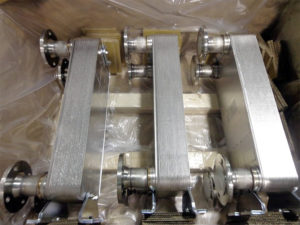Heat exchangers selection
A heat exchanger is a thermodynamic component that allows the energy transfer in form of heat between two fluids. On the market there are several kinds of heat exchangers, for applications such as district heating, boilers and refrigeration. The heat exchanger is indeed a high versatile machinery, that can be designed and engineered to suit the most different products and processes’ characteristics.
Heat exchangers are nowadays employed within all industry sectors, for thermostatation, thermoregulation and heat recovery purposes, wherever it is required to heat or cool working fluids employed in machinery or industrial equipments. Heat exchangers are passive and static machines, as they don’t have any moving part (exception for the fans in air/liquid exchangers) and they operate simply transferring thermal energy – nor consuming or either creating it – taking advantage of the natural thermal transfer that occurs between two fluids at different temperatures.
Thermal transfer is a natural physical process based on the principle that energy in a system always tend to an equilibrium, spreading therefore within the fluids aiming to achieve a uniformity of temperatures.
Exchangers exist as air or water exchangers, both employed using the most different kind of process fluids, and the thermal transfer can happen both for direct contact or in an indirect way. In direct contact exchange, or mixing, two immiscible fluids are brought in contact at first, and then again separated, as it happens in cooling towers where water gets cooled by direct contact with air. In indirect heat exchangers, or surface exchangers, the type we’re going to explain here more in depth, the two fluids are instead separated by an exchange surface, a thin metallic partition wall, a metallic plate or the pipe of a coil, which acts as transmission media for the heat transfer between the fluids.
There are several different kinds of heat exchangers, based on how the thermal transfer is achieved: shell and tube heat exchangers are ideally suited for heat recovery from exhaust fumes in cogeneration plants that use endothermic engines. These are traditionally employed here, but recently they are being replaced with plate heat exchangers, a more compact and efficient solution (lower water consume and higher thermal performance). Then there are also spiral heat exchangers, block type heat exchangers and finned pack heat exchangers.
In order to proceed with a first macro selection of the most suitable type of exchanger to be employed, the kind of thermal exchange that has to be achieved must be determined. For example, heat dissipation tasks are indeed mostly suited by finned pack exchangers, using thermal transfer between low pressure gaseous fluids and liquids (dry cooler, radiators, free cooler, etc.).




 Back to index
Back to index Download the complete book
Download the complete book